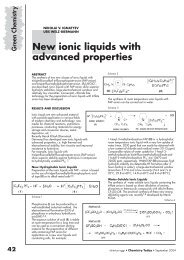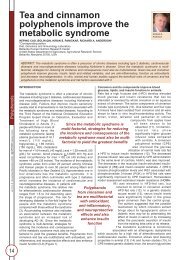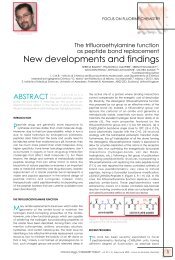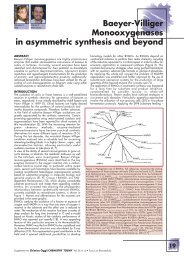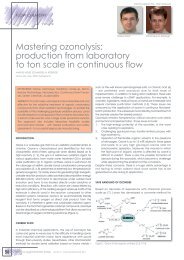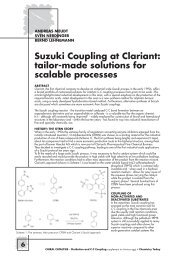Lake Como 2|4 October 2011 - CHIMICA Oggi/Chemistry Today
Lake Como 2|4 October 2011 - CHIMICA Oggi/Chemistry Today
Lake Como 2|4 October 2011 - CHIMICA Oggi/Chemistry Today
You also want an ePaper? Increase the reach of your titles
YUMPU automatically turns print PDFs into web optimized ePapers that Google loves.
Huisgen cycloaddition to rufi namide: pressure impact on reaction environment and<br />
kinetics<br />
Svetlana Borukhova a , Alvaro C. Varas a , Volker Hessel a , Qi Wang a , Paul Watts b , Charlotte Wiles c<br />
a Eindhoven University of Technology, Department of Chemical Engineering & <strong>Chemistry</strong>, The Netherlands<br />
b Department of <strong>Chemistry</strong>, University of Hull, United Kingdom<br />
c Chemtrix BV, Geleen, The Netherlands<br />
Click <strong>Chemistry</strong> is a multi-step synthetic concept recently introduced by Sharpless (1).<br />
The variant of the Huisgen 1,3-dipolar cycloaddition paves new routes into the discovery and production of drugs.<br />
This work will follow the fi rst fl ow route for Click chemistry, most recently developed (2).<br />
We aim at high-temperature operation to speed up the reaction to industrial productivity and high-pressure operation with<br />
extended (dielectric constant ε, viscosity η, and reaction constant k) material and kinetic parameter space - with hope for a<br />
catalyst-free process while maintaining stereoselectivity.<br />
Then, a commercial drug, Rufi namide, which was reported to be in the top-200 best selling<br />
drugs of recent years (3), would be synthesized under intensifi cation of its fl ow synthesis.<br />
POSTER POSTER POSTER POSTER POSTER POSTER POSTER POSTER POSTER POSTER POSTER POSTER POSTER POSTER POSTER POSTER POSTER POSTER POSTER POSTER POSTER POSTER POSTER POSTER POSTER POSTER POSTER POSTER POSTER POSTER POSTER POSTER POSTER POSTER POSTER POSTER POSTER POSTER POSTER POSTER POSTER POSTER POSTER POSTER<br />
10 10 10 10 10 10 10 10 10 10 10 10 10 10 10 10 10 10 10 10 10 10 10 10 10 10 10 10 10 10 10 10 10 10 10 10 10 10 10 10 10 10 10 10 10 10 10 10 10 10 10 10 10 10 10 10 10<br />
Using commercial equipment (Labtrix ® S1 system from Chemtrix BV) a safe and effi cient way<br />
of organic azide preparation under continuous fl ow at decreasing the reaction time was<br />
demonstrated, to get acquainted with the fi rst step in Click <strong>Chemistry</strong>.<br />
3-Phenylpropyl methanesulfonate and 1-bromo-3-phenylpropane were converted to the<br />
respective azides ((3-azidopropyl)benzene) at 100% conversion in 30 s.<br />
Chemical intensifi cation was needed and achieved via a high-T route (195˚C) for 1-chloro-3phenylpropane<br />
2, which is only a fair leaving group; achieving then complete conversion<br />
in 20 min for a 1:1 reactant ratio.<br />
Using high-c conditions in addition (doubling the azide salt) reduced the time for complete<br />
conversion further to 60 s.<br />
In new research, the synthetic plan is to start with 2,6-difl uorobenzylchloride and sodium azide<br />
salt to produce alkyl azide, which will then react according to a procedure proposed (4)<br />
with methyl 3-methoxyacrylate to yield a [3+2] cycloaddition product, that when treated with<br />
ammonia in methanol will result in a precipitated product, Rufi namide.<br />
Massive speed-up of the Rufi namide synthesis is expected to achieve under superheated<br />
conditions, through the exponential dependence of the reaction rate on temperature as<br />
described by Arrhenius equation.<br />
The same can be achieved by pressure only - chemical equilibria and rates as well as the<br />
Gibbs’ enthalpies of reaction and activation volumes are strongly infl uenced by pressure –<br />
caused by the pressure-induced changes of physical properties of matter such as density,<br />
viscosity, dielectric constant, or conductivity.<br />
The model reaction is to be studied under the pressures up to 2000 bars in this research.<br />
Normally, a copper catalyst is used to block one of the addition sites of the alkynes (enes) in<br />
Click <strong>Chemistry</strong>.<br />
Instead and to simplify the process, we propose to use steric hindrance, normally seen as an<br />
obstacle in reactions, to reach similar stereoselectivity by virtue of the pressure effect, resulting<br />
in a catalyst-free process.<br />
(1) Kolb H.C., Sharpless, K.B. Drug Discov.<strong>Today</strong>, 2003, 8, 1128.<br />
(2) Smith C.D. , Org. Biomol. Chem., 2007, 5, 1559.<br />
(3) Baumann M., Baxendale I.R., J. Org. Chem.,<strong>2011</strong>, 7, 442.<br />
(4) Mudd W.H., Stevens E.P., Tetrahedron Letters, 2010, 51, 3229.<br />
28<br />
<strong>Lake</strong> <strong>Como</strong><br />
<strong>2|4</strong> <strong>October</strong> <strong>2011</strong>



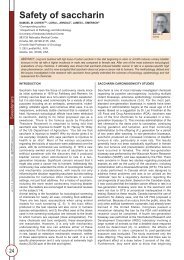
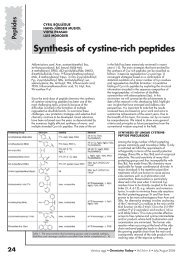
![Pietro Delogu [modalità compatibilità]](https://img.yumpu.com/12255149/1/190x135/pietro-delogu-modalita-compatibilita.jpg?quality=85)
